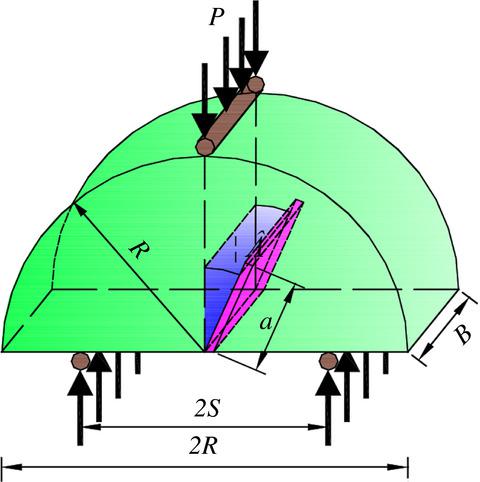当前位置:
X-MOL 学术
›
Energy Sci. Eng.
›
论文详情
Our official English website, www.x-mol.net, welcomes your
feedback! (Note: you will need to create a separate account there.)
Influence of supercritical, liquid, and gaseous CO2 on fracture behavior in sandstone
Energy Science & Engineering ( IF 3.5 ) Pub Date : 2020-09-23 , DOI: 10.1002/ese3.736 Ze‐dong Sun 1, 2 , Xuan‐min Song 1, 2 , Gan Feng 3 , Yu‐ming Huo 1, 2 , Zhong‐Lun Wang 1, 2 , Shao‐qi Kong 1, 2
Energy Science & Engineering ( IF 3.5 ) Pub Date : 2020-09-23 , DOI: 10.1002/ese3.736 Ze‐dong Sun 1, 2 , Xuan‐min Song 1, 2 , Gan Feng 3 , Yu‐ming Huo 1, 2 , Zhong‐Lun Wang 1, 2 , Shao‐qi Kong 1, 2
Affiliation

|
Storing CO2 in geological formations can reduce the amount of greenhouse gases in the atmosphere. In order to explore the fracture behavior of caprock during CO2 geological storage, three caprock adsorption experiments for supercritical, liquid, and gaseous CO2 were designed. The fracture toughness of mode I, mode II, and mixed‐mode I/II of sandstone before and after the experiment was tested, and X‐ray diffraction (XRD), X‐ray fluorescence (XRF), and scanning electron microscopy (SEM) were used to examine the fracture mechanical characteristics of sandstone. Results showed that the pure mode I fracture toughness of sandstone immersed in supercritical CO2 (ScCO2), liquid CO2, and gaseous CO2 for 30 days decreased by 27.89%, 11.01%, and 17.43%, respectively, compared to nonimmersed sandstone. Pure mode I fracture toughness was more sensitive than mixed‐mode I/II and pure mode II fracture toughness to the various CO2 phase states. Furthermore, the ability of sandstone to resist fracture and failure was significantly reduced by the adsorption of CO2 in different phases. The effects of the different phases were in the following order: ScCO2 > gaseous CO2 > liquid CO2. The decreased ability of sandstone to resist fracture was primarily due to the geophysical and chemical reactions between CO2 and minerals, the alteration of minerals, or the formation of new substances. SEM observations showed that liquid CO2 adsorption caused the sandstone to undergo intergranular fracture, and the adsorption of gaseous CO2 promoted the occurrence of transgranular fractures. In particular, due to the ScCO2 adsorption, various fracture forms such as intergranular fractures, transgranular fractures, and mutual coupling fractures existed simultaneously. Sandstone exhibited numerous fractures and pores, and fracture resistance was weakened. Results of this study have important significance for evaluating the stability and safety of CO2 geological storage.
中文翻译:

超临界,液态和气态二氧化碳对砂岩断裂行为的影响
将CO 2储存在地质构造中可以减少大气中温室气体的数量。为了探索盖层在CO 2地质存储过程中的断裂行为,设计了三个超临界,液态和气态CO 2盖层吸附实验。测试了实验前后砂岩的I型,II型和I / II混合模式的断裂韧性,并进行了X射线衍射(XRD),X射线荧光(XRF)和扫描电子显微镜(SEM)的测试)被用来检查砂岩的断裂力学特性。结果表明,浸在超临界CO 2(ScCO 2),液态CO 2中的砂岩的纯I型断裂韧度与未浸入的砂岩相比,30天的CO2和气态CO 2分别降低了27.89%,11.01%和17.43%。纯模式I的断裂韧度比混合模式I / II和纯模式II的断裂韧度对各种CO 2相态更敏感。此外,通过在不同相中吸附CO 2,砂岩抵抗断裂和破坏的能力大大降低。不同阶段的影响按以下顺序排列:ScCO 2 >气态CO 2 >液态CO 2。砂岩抗断裂能力下降主要是由于CO 2之间的地球物理和化学反应和矿物质,矿物质的改变或新物质的形成。SEM观察表明,液态CO 2的吸附导致砂岩发生晶间断裂,而气态CO 2的吸附促进了穿晶断裂的发生。特别地,由于ScCO 2的吸附,同时存在多种裂缝形式,例如晶间裂缝,穿晶裂缝和相互耦合裂缝。砂岩显示出许多裂缝和孔隙,抗裂性减弱。研究结果对评价CO 2地质封存的稳定性和安全性具有重要意义。
更新日期:2020-11-16
中文翻译:

超临界,液态和气态二氧化碳对砂岩断裂行为的影响
将CO 2储存在地质构造中可以减少大气中温室气体的数量。为了探索盖层在CO 2地质存储过程中的断裂行为,设计了三个超临界,液态和气态CO 2盖层吸附实验。测试了实验前后砂岩的I型,II型和I / II混合模式的断裂韧性,并进行了X射线衍射(XRD),X射线荧光(XRF)和扫描电子显微镜(SEM)的测试)被用来检查砂岩的断裂力学特性。结果表明,浸在超临界CO 2(ScCO 2),液态CO 2中的砂岩的纯I型断裂韧度与未浸入的砂岩相比,30天的CO2和气态CO 2分别降低了27.89%,11.01%和17.43%。纯模式I的断裂韧度比混合模式I / II和纯模式II的断裂韧度对各种CO 2相态更敏感。此外,通过在不同相中吸附CO 2,砂岩抵抗断裂和破坏的能力大大降低。不同阶段的影响按以下顺序排列:ScCO 2 >气态CO 2 >液态CO 2。砂岩抗断裂能力下降主要是由于CO 2之间的地球物理和化学反应和矿物质,矿物质的改变或新物质的形成。SEM观察表明,液态CO 2的吸附导致砂岩发生晶间断裂,而气态CO 2的吸附促进了穿晶断裂的发生。特别地,由于ScCO 2的吸附,同时存在多种裂缝形式,例如晶间裂缝,穿晶裂缝和相互耦合裂缝。砂岩显示出许多裂缝和孔隙,抗裂性减弱。研究结果对评价CO 2地质封存的稳定性和安全性具有重要意义。











































 京公网安备 11010802027423号
京公网安备 11010802027423号